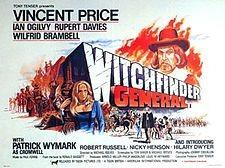Vincent Price Vs Michael Reeves: the making of Witchfinder General
In the autumn of 1967, the actor Vincent Price arrived in England to begin work on a low-budget horror film titled Witchfinder General, to be directed by the twenty-four-year-old Michael Reeves. Vincent Price was a world-famous American actor, while the English Michael Reeves had previously directed only two feature films and had been 2nd assistant director on another. Theirs was to be one of the most volatile relationships ever witnessed on a film set, but Witchfinder General would become a highly celebrated horror film, featuring one of Vincent Price's greatest performances.

Vincent Price made his film debut in 1938, and his horror film debut in 1939 in the film Tower of London, appearing alongside legendary horror actor Boris Karloff. Over the following decades he gained fame and acclaim for his performances in numerous horror films, and also for his many villainous roles in thrillers and mysteries.
In the 1960s he starred in a number of successful low-budget horror films directed by Roger Corman, many of them adaptations of works by Edgar Allan Poe, such as The Pit and the Pendulum and The Masque of the Red Death.
Director Michael Reeves had co-wrote the screenplay for this historical horror film. It’s a largely fictionalised account of the notorious witch-finder Matthew Hopkins, a lawyer who falsely claimed to have been appointed as a Witch Finder General by Parliament during the English Civil War. In fact, he never received an official mandate to hunt witches. Hopkins is believed to have been responsible for the executions of three hundred alleged witches between the years 1644 and 1646.
Reeves initially planned to have Donald Pleasence play the role of Hopkins, but interference from the production's American co-financiers resulted in Price taking the part. This resulted in resentment on the part of Reeves, who was open with colleagues that Price was not his preferred choice for the role of the Witchfinder General, and his comments were made known to Vincent Price before he left the United States. Reeves declined to meet Price at Heathrow Airport, a snub which offended the celebrated actor.
Production on the film began in East Anglia in September 1967. On location, when director and actor met for the first time, Reeves told Price "I didn't want you, and I still don't want you, but I'm stuck with you".
The relationship continued on an adversarial note. After Reeves asked Price to tone down his over-acting and to play the role more seriously, Price told the young director "Young man, I've made eighty-four films. What have you done?" Reeves replied "I've made three good ones".
In one scene, Reeves required Price to shoot his pistol between the ears of the horse he was riding. Price expressed unease at the possible reaction of the horse, but the director insisted. When the gun went off, the horse reared and Price was thrown to the ground, though luckily unhurt.
Price was drunk on set during the final day of filming. Incensed at this, Reeves instructed actor Ian Ogilvy, for the death scene of Price's character, to "really lay into Vincent" with the stage axe. Ogilvy duly obliged, but a producer had luckily fitted Price's costume with protective foam padding which prevented injury.
Price afterwards said "Reeves hated me. He didn't want me at all for the part. I didn't like him either". He also said Reeves “could not communicate with actors".
Released in 1968, the finished film included scenes of torture and violence that were considered unusually gruesome at the time, and was met with disgust by several UK film critics, including the writer Alan Bennett.
However, in the years since its release, many prominent critics have championed the film. In 2005, the magazine Total Film named it the fifteenth-greatest horror film of all time. It is now often called one of the greatest horror films that Britain has produced, and has retrospectively come to be seen as a prime example of a subgenre called "folk horror", which would also include later films such as The Blood on Satan's Claw and The Wicker Man.
There was also something of a reconciliation between Price and Reeves. After seeing the film in 1969, Price wrote to the director a ten-page letter praising the film, acknowledging that he finally understood what Reeves had been after. Reeves wrote back "I knew you would think so".
Vincent Price would continue to have a successful career in acting. Notable later films included The Abominable Dr. Phibes, Theatre of Blood, and Tim Burton's Edward Scissorhands. In the 1980s, he reached a younger generation when he provided the spoken-word sequence for the Michael Jackson song Thriller. He died, at age eighty-two, in 1993.
Michael Reeves suffered from depression and insomnia, for which he took tablets and received a variety of treatments. He was found dead on the morning of 11th February 1969, only nine months after the release of Witchfinder General. He was twenty-five. His death was due to an accidental alcohol and barbiturate overdose. Britain had lost one of its most promising young film-directors at a tragically young age.
Alan, Malahide Library